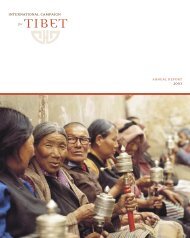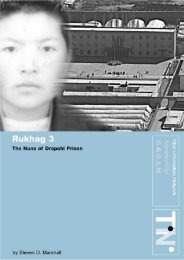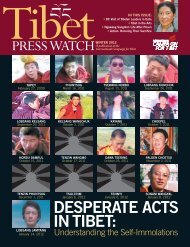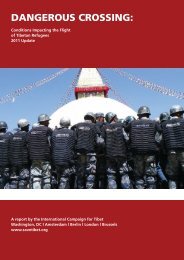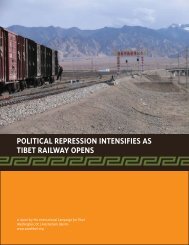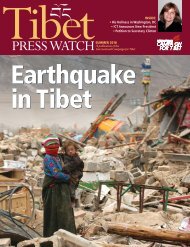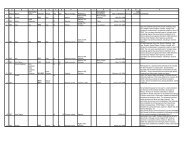download the report - International Campaign for Tibet
download the report - International Campaign for Tibet
download the report - International Campaign for Tibet
- No tags were found...
You also want an ePaper? Increase the reach of your titles
YUMPU automatically turns print PDFs into web optimized ePapers that Google loves.
NEPAL’S CHANGING WELCOMEThe Nepalese government has historically maintained an accommodatingattitude toward <strong>Tibet</strong>an refugees, a generous response from such a poorcountry. vii From 1959 to <strong>the</strong> mid-1970s, <strong>Tibet</strong>an refugees were allowedto remain in Nepal but were not granted legal status. In late 1974, <strong>the</strong>Nepalese government instituted a registration process and registeredclose to 15,000 refugees as residents of Nepal. For <strong>the</strong> next 15 years,<strong>the</strong> Nepalese policy was one of neutral non-action.In 1989, as <strong>the</strong> flow of refugees again surged in <strong>the</strong> wake of political uprisingsinside <strong>Tibet</strong>, <strong>the</strong> Nepalese government came to an arrangementwith <strong>the</strong> UNHCR, whereby <strong>Tibet</strong>an refugees arriving after December 31,1989, would not be allowed to resettle in Nepal but <strong>the</strong> UNHCR wouldinterview <strong>the</strong>m, designate <strong>the</strong>m as “persons of concern” as appropriate,and facilitate <strong>the</strong>ir prompt, safe transit to India <strong>for</strong> resettlement <strong>the</strong>re.This arrangement became known as <strong>the</strong> “gentlemen’s agreement.” Itwas never written down or <strong>for</strong>malized but worked well <strong>for</strong> over a decadewith relatively few disruptions. The UNHCR office in Kathmandu wasable to receive refugees in a routine manner and process <strong>the</strong>m with <strong>the</strong>cooperation of <strong>the</strong> Nepalese Department of Immigration (DOI).Over <strong>the</strong> past four years, <strong>the</strong> “gentlemen’s agreement” appears to havebroken down on <strong>the</strong> Nepalese government’s side. At <strong>the</strong> end of 2002its future viability was in grave doubt. Since 2001, <strong>the</strong> Nepalese governmenthas been arresting more <strong>Tibet</strong>ans, including newly arrived refugeesfrom <strong>Tibet</strong>, <strong>Tibet</strong>ans seeking to repatriate to <strong>Tibet</strong>, and o<strong>the</strong>r <strong>Tibet</strong>ansfound in and around Kathmandu without a registration certificate. Withincreasing frequency, <strong>the</strong>y are not turned over to <strong>the</strong> UNHCR as <strong>the</strong>ywere in <strong>the</strong> past but are tried on immigration violations and fined andsentenced to jail terms.The UNHCR operations in Nepal, reeling from a management crisisduring 2002, have also faced increasing restrictions on <strong>the</strong>ir protectionactivities. Most of <strong>the</strong>se restrictions are related to legitimate securityconcerns arising from <strong>the</strong> Maoist insurgency, but <strong>the</strong> net result has beenan increasingly insecure environment <strong>for</strong> <strong>Tibet</strong>an refugees transitingNepal. In a related and equally ominous development, <strong>the</strong> Nepalesegovernment has stepped up its harassment of <strong>the</strong> legally resident<strong>Tibet</strong>an refugee community. Each of <strong>the</strong>se issues will be discussed atgreater length below.8



